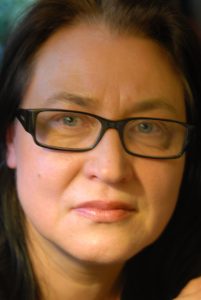Creativity Through Constraints
Hanna Kryszewska is a teacher, teacher trainer, trainer of trainers. She is a senior lecturer at the University of Gdańsk, Poland. She is co-author of resource books: Learner Based Teaching, OUP, Towards Teaching, Heinemann, The Standby Book, CUP, Language Activities for Teenagers, CUP, The Company Words Keep, DELTA Publishing, and a course book series for secondary schools: ForMat, Macmillan. She is also co-author of a video based teacher training course: Observing English Lessons. Hania is a Pilgrims trainer and editor of HLT Magazine.
E-mail: hania.kryszewska@pilgrims.co.uk

Introduction
Some might perceive constraints an obstacle. However, limitations or limits can be inroads to creativity, take haiku, tanka or sijo. Here are some examples:
https://www.masterclass.com/articles/short-poetic-forms-to-know#want-to-learn-more-about-poetry . In a language class we may want to use simpler ideas before we branch out into poetry. Here are two ideas for speaking which is real fun. More ideas in the next issues of HLT.
How many words?
- Put the students into groups of 3. Ideally they should be sitting on three chairs.
- Tell them who is A, who B and who C, e.g.

A B C
- Choose a topic e.g. your last holidays.
- Tell the students that A and C will have a conversation on the topic. C will tell them how many words they are allowed to use for each utterance (You may set a limit e.g. of max. 10 words).
- Explain it is OK to slow down, think what to say and count words.
It goes roughly like this:
B number
A speaks
B number
C speaks
B number
C speaks
B number
A speaks etc.
Example
B: 3
A: Your last holiday?
B: 2
C: not bad
B: 2
C: And you?
B: 6
A: Went to Paris with my girlfriend.
B: 3
A: Very nice place
B: 4
C: Have not been there!
B: 7
C: Would you recommend it for a weekend?
B: 3
A: Too little time etc.
- Stop the activity when you think it is the right moment. You may say: You have one minute to bring the conversation to a close.
Variation
If you want to use the dialogue for further work you could have the learners record it on their phones or have a fourth person (D) who will be the secretary and will write the dialogue down.
Pick a word
- Put the students into groups of 3.
- Tell them two people (A and B) are going to have a dialogue, the third (C) will be monitoring the activity.
- Suggest a theme e.g. films
- Person A starts e.g. Do you like going to the cinema?
- Person B answers but he/she must use one word from the utterance A has just made e.g. Cinema is really boring! I prefer watching films on my computer.
- Then A may say reacting to B’s utterance: I find the computer screen is too small.
- Tell them that it is OK to stop and think what to say.
- Person C makes sure that A and B follow the rules and really pick a word.
- At some point student C can swap roles with A or B.
- Stop the activity when you think it is the right moment. You may say: You have one minute to bring the conversation to a close.
Variation
Person C may document the dialogue by writing it down. The teacher will then be able to check it for accuracy and do further language work.
Rationale
These activities work well with weaker learners and those who are shy to speak. When giving the instructions the teacher needs to reinforce that stopping and thinking what to say or counting the words is built into the activity. There is no pressure to respond immediately. The conversation will not flow smoothly because the speaker will look for the language to take the limitations on board. The role of the observer is very important too; he or she may learn a lot by observing the speakers’ strategies, by orchestrating the conversation when giving the number of words and by just listening. Needless to say, at some point the observer may swap roles with one of the speakers.
The language the learners produce is very interesting as they will intuitively use features of spoken grammar, especially hedging, ellipsis and fixed expressions. The activities are a great starting point to work on spoken grammar.
Please check the Enhancing Language Learning through Creativity course at Pilgrims website.
Please check the Creating a Motivating Environment course at Pilgrims website.
Please check the CLIL for Secondary Teachers course at Pilgrims website.
Please check the How to teach spoken English course at Pilgrims website.
Creativity Through Constraints
Hanna Kryszewska, Poland